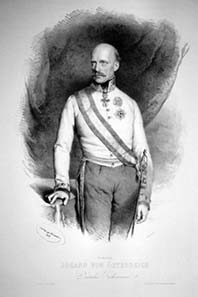January 28, 2011 – On January 26, the Austrian Mint issued a gold coin celebrating the 200th anniversary of the founding of the Joanneum Museum in Graz, in the province of Styria, Austria. The museum collection covers many centuries and many disciplines so that it is known as the “Universal Museum.”
Austria. 50 Euro “Joanneum in Graz”, 986 Au, 10 g, 22 mm, Design: H. Wähner / H. Andexlinger, Mintage: max 50.000 PP.
The obverse of the coin depicts a collage of the classical façade of the main entrance to the museum, with the very modern and organic roof of the art gallery in the background. On the left side of the obverse, part of the perfectly trimmed landscape can be seen in the luscious round tree with part of a hedge at its base. Tucked into the hedge is the year of issue 2011 and below it is the word “Kunsthaus” or Art Gallery. Also on this side appear the country of issue, “Republik Oesterreich” or Republic of Austria, and the face value of 50 euros. The obverse of the coin was designed by mint engraver Helmut Andexlinger.
Joanneum Graz / Kunsthaus. Foto: Marion Schneider & Christoph Aistleitner / Wikipedia.
The reverse of this gold coin depicts the ornately embossed armour made by Michael Witz the Younger in Innsbruck circa 1550. To the right-hand side is part of the armoury collection, located in the “Landeszeughaus Graz” or Styrian Armoury, and is part of the Joanneum. The roof in which this part of the armoury collection is maintained has a classic coffered ceiling, as seen in the beams in the top right quadrant of the design. The reverse of the coin was designed by mint engraver Herbert Waehner.
Erzherzog Johann in 1848. Source: Wikipedia.
The Joanneum was originally founded by the Habsburg Archduke Johann in 1811 as a public museum to pursue enlightenment for all. Initially the Joanneum was an educational institution focusing on nature and technology. Over the years a museum was established because of the continually growing donations and collections. The museum complex now includes seemingly everything, from scientific and technical materials, to modern and older arts and crafts, coins, sculpture, hunting, agriculture, cultural history and so on, spanning the centuries from Roman times to modern day.
The “Friendly Alien”. Photo: Marion Schneider & Christoph Aistleitner / Wikipedia.
The very modern and flowing organic building now housing the art collection was completed in 2003 to coincide with the designation of Graz as the cultural city of Europe. The building was designed by Peter Cook and Colin Fouriner of London, who affectionately think of their design in Graz as the “Friendly Alien.” A Berlin design firm founded by brothers Jan and Tim Edler enhanced this alien look by adding a sophisticated computer-controlled lighting system called BIX that seemingly makes the whole building glow, somewhat like a “display-skin” enveloping the building. This system has become the international benchmark for the fusion of architecture, art and media. The BIX system developed by the Edler firm has now also become part of New York’s Museum of Modern Art (MoMa) recognizing its breakthrough development fusing such diverse elements into one medium of human communication.
The elaborate suit of three-quarter parade armour made by Michael Witz the Younger from Innsbruck for a nobleman as seen on the reverse of the coin is part of the Styrian Armoury which is the largest historic armoury collection in the world and today contains about 30,000 pieces of armour. The armour, made from iron with embossed scrollwork and leather straps, is from 1550. Michael Witz, the Younger was one of the most important armour makers in the middle of the 16th century.
Presentation of the Coin: from l. to r.: Prisca Havranek-Kosicek, Leiterin Abteilung Philatelie, POST AG; Peter Pakesch, Intendant Universalmuseum Joanneum; Claudia Macheiner, Leiterin der OeNB Zweiganstalt Region Süd; Gerhard Starsich, Vorstandsdirektor Münze Österreich AG;Foto: UMJ / N. Lackner.
The new coin is struck in .986 fine gold (10 g) with a maximum mintage of 50,000 pieces in proof quality only. In contrast to the previous 50 Euro gold coins from the Austrian Mint, these coins have a highly polished background and frosted relief. Each coin contains 10 grams of fine gold and has a diameter of 22 mm. Each coin is encapsulated and packed in a box with a numbered certificate of authenticity. The accompany certificate is six pages long and provides detailed information about the technical specifications and design of the coin.
If you want to learn more about the Austrian Mint, click here.
If you want to visit the Joanneum Museum, click here.
If you want to learn more about the fabulous coin collection of the Joanneum, you will certainly find the best information at CoinsWeekly, click here.








